
ATSU’s approach to unifying its social strategy across departmental divides has yielded an 879% increase in organic reach on Facebook.
by Anne Ackroyd, Public Relations Specialist, A.T. Still University
Over the past year, while most public pages have seen a significant decrease in organic reach on Facebook, A.T. Still University (ATSU) has seen an 879% increase (comparing June 2017 to June 2016). One of the major factors in ATSU’s success has been an innovative, university-wide social media committee, developed to overcome departmental divides and build a more unified social media presence.
In early 2017, ATSU’s marketing team determined that the quantity of university-affiliated social media pages was undermining the institution’s reach and engagement. This problem is not unique to ATSU, a small graduate health sciences school of about 3,000 students. A quick search on Facebook for your alma mater will likely reveal dozens of pages that bear some variation of the institution’s logo. The problem stems from the silo mentality that plagues higher education. Faculty, staff and students often identify strongly with their area of study, rather than with the institution as a whole.
In addressing this issue, ATSU developed a replicable model for a social media committee tailored to the needs of higher education.
The Problem
ATSU is a diverse institution, comprised of six schools, two campuses, and a wide variety of programs and departments. All these moving parts are united by the university’s rich history and a commitment to its mission. However, until recently, the institution’s social media presence did not reflect this solidarity. Instead, it revealed a culture of silos. Social media pages had been created to represent every niche within the university, detracting from the success of the main social media channels run by a small, centralized marketing department.
The first step to building a more unified social media presence was identifying all the accounts that had been created from within the university. It was a monumental undertaking. Over the course of several weeks, the marketing team tracked down more than 200 ATSU-affiliated pages and groups. About a third of these accounts were completely inactive. Most had fewer than a couple hundred followers.
All this clutter affected the university’s reach and engagement in the following ways:
- It was difficult to search for and find ATSU’s main pages.
- It was not feasible to monitor and enforce brand compliance across this many accounts.
- It divided the university’s audience on social media.
- It distorted analytics, making it difficult to measure the true reach of university content.
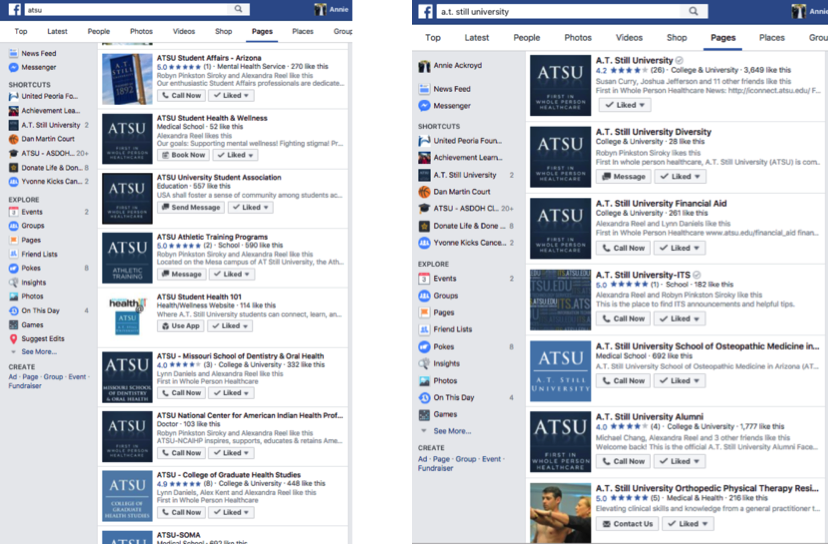
Searching for “ATSU” or “A.T. Still University” on Facebook in early 2017 turned up hundreds of results. It was nearly impossible to find the university’s primary page.
In speaking with program page managers across the university, the marketing team learned that there were many misconceptions about the purpose of social media and how to use it effectively. Many page managers felt that their program was underrepresented on the university’s main pages, driving them to take program marketing into their own hands. It was evident that a solution would need to give all programs a voice on the primary social media channels, while also providing instruction to university page managers on social media best practices.
The Solution
The marketing team identified a three-part solution to ATSU’s social media woes:
- Create opportunities for representation and engagement on social media for stakeholders within the university, building a network of brand champions.
- Develop a unified voice for the university across all pages, consistent with brand standards and social media best practices.
- Reduce the number of accounts affiliated with the university, while making it easier to search for and find the primary pages.
The social media committee was designed to meet all of these needs. Membership is open to anyone at the university – faculty, staff and students. Today, the committee has more than 70 members, representing all six schools, both campuses, online programs, and most departments.
Monthly meetings give program page managers, and anyone with an interest in social media, consistent access to the marketing team, creating opportunities for social media representation and engagement across the institution. Committee members are also invited to submit post requests through a form available in the university portal. By creating a formal process for content submission, the marketing department has shifted responsibility for social media representation back to the programs.
To nurture brand champions, the marketing team provides the committee with structured opportunities to engage with the university on social media. For example, committee members are entered in a monthly raffle when they share or retweet one of ATSU’s posts. Two minutes of every committee meeting are devoted to “Social Media War Room,” in which committee members are asked to take out their smartphones and spend time engaging with the university’s content. Activities like these provide a fun outlet for school spirit and incentivize meaningful engagement.
Committee meetings also allow the marketing team to provide ongoing professional development in social media best practices to page managers across the university. Topics have included the following:
- How to use hashtags purposefully.
- How to take great photos for social media on a mobile device.
- How to develop a voice for your brand.
Program page managers then apply these strategies to their content development, ensuring all university-affiliated pages adhere to best practices.
A key component of improving ATSU’s social media presence has been cleaning up the university’s search results, making it easier to find the main pages and distinguish between program pages. Through the committee, the marketing team implemented a consistent format for university page names and profile images.

New formula for naming ATSU-affiliated social media pages
Rather than demanding that departments shut down their pages, the marketing team created shared goals and built investment across the university. Program representatives opted in, agreeing to solutions recommended by the marketing team. Some chose to shut down their pages, while others adopted best practices and updated page branding. Because they agreed to the solution and have been involved in its implementation, program representatives have grown to be brand champions, engaging with the university’s social media content often and in meaningful ways.
The Results
Since the committee’s inception, ATSU has seen incredible improvement in social media content, analytics, and quality of engagement:
- Perhaps the most significant result of ATSU’s social media committee and best practices initiative has been the astounding growth in reach and engagement on the university’s main pages. Below is a comparison of Facebook and Twitter average reach and engagement for one month in 2016 to the same month in 2017.
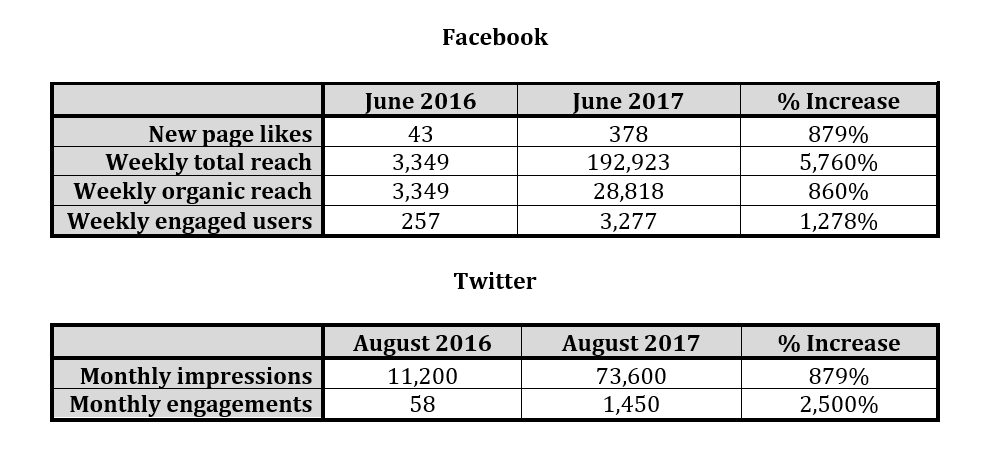
- After closing out inactive pages and implementing consistent page names and profile images across the remaining university-affiliated accounts, it is much easier to search for ATSU on Facebook.

Searching for “A.T. Still University” on Facebook before and after rollout of the new page naming system and profile images.
- Committee meetings have created opportunities for collaborative content development, resulting in many engaging social media campaigns.

“Past in the present” photo series in collaboration with the Museum of Osteopathic Medicine.

#ThisIsATSU in collaboration with ATSU’s College of Graduate Health Studies.
 Reminders from Bucky, in collaboration with Enrollment Services.
Reminders from Bucky, in collaboration with Enrollment Services.

#ATSUAccepted, poster shared with admitted students, in collaboration with Admissions.
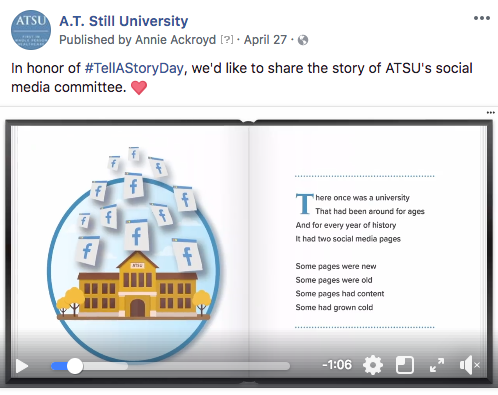 Tell a Story Day video, narrated by ATSU’s social media committee members.
Tell a Story Day video, narrated by ATSU’s social media committee members.
- By providing structured opportunities for committee members to interact with its pages, ATSU has built a highly engaged network of brand champions:
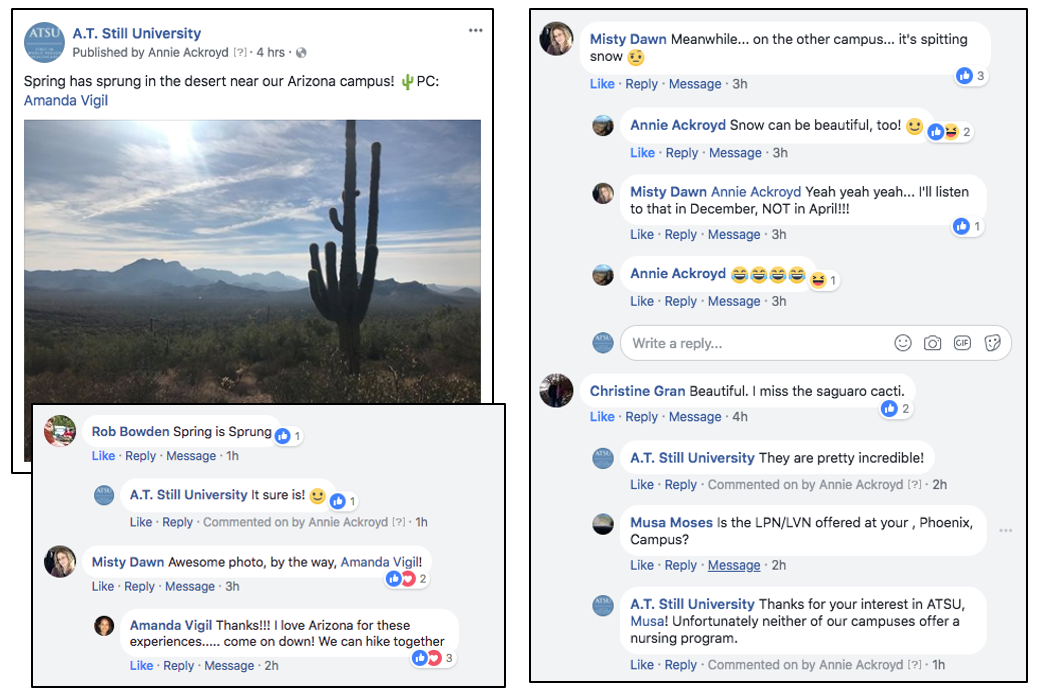 Committee members leave long, thoughtful comments and engage in discussions on ATSU’s posts.
Committee members leave long, thoughtful comments and engage in discussions on ATSU’s posts.

Committee members share ATSU’s posts, including thoughtful personal captions.
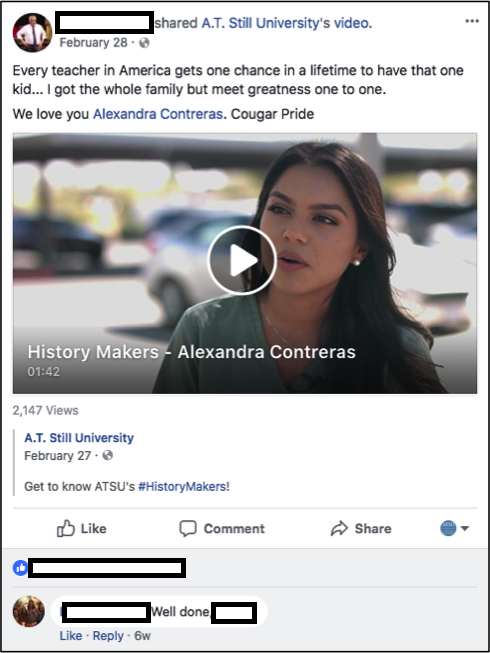
Friends and family of committee members share ATSU’s posts, increasing the university’s reach exponentially.
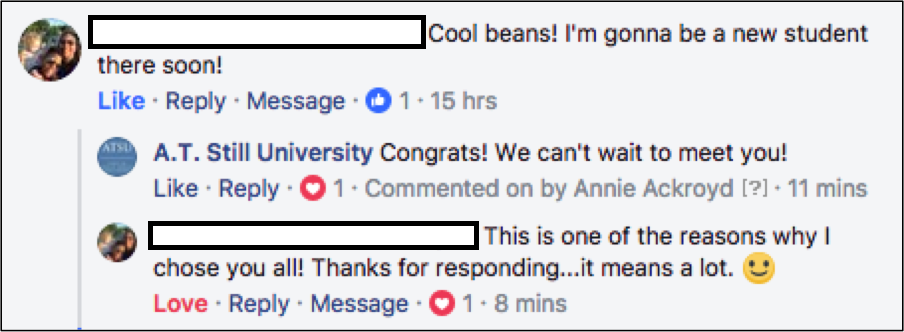
By building a sense of community around its social media pages and nurturing strong relationships with its followers, ATSU ensures its social media efforts have meaningful ROI.
Takeaways
Social media managers at other institutions who are facing similar problems may ask themselves the following:
- Are we tracking all accounts affiliated with the university?
- What avenues exist for university stakeholders to provide feedback on the primary accounts?
- How do we ensure all programs are represented on the main social media channels?
- How do we measure and communicate success?
- What are our benchmark analytics?
- How often will we measure growth, and using what metrics?
- With whom will we share the results of our efforts, and how often?
- How do we make data accessible to stakeholders outside of the marketing department?
- How do we leverage stakeholders’ enthusiasm for the university (employees, faculty, students, alumni) to build a highly engaged network of brand champions?
Feel free to contact ATSU’s public relations specialist, Anne Ackroyd, at anneackroyd@atsu.edu with questions.

